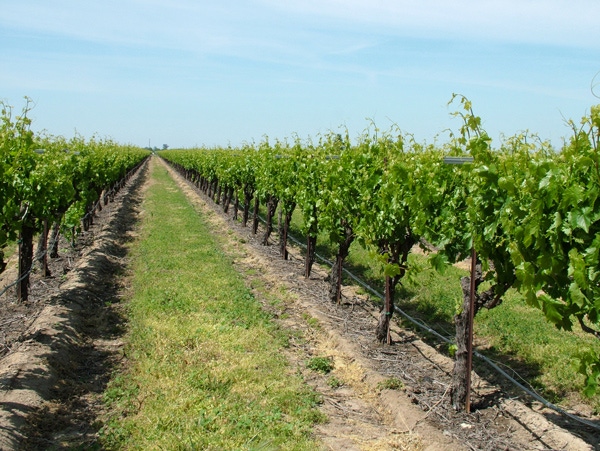
With more and more wine grape growers in the San Joaquin Valley pulling out vineyards in pursuit of more profitable uses of their land, some observers see the region’s wine industry beginning to decline.
Peterangelo Vallis, executive director of the San Joaquin Valley Winegrowers Association, isn’t buying it.
“Our growers absolutely have a future in wine grapes,” he says.
Long considered the backbone of California’s wine grape industry, the San Joaquin Valley produced nearly 60 percent of all wine grapes crushed by the state’s processors last year.
A portion of these grapes are sold for blending with grapes grown in the Central Coast and North Coast areas to produce wines at the higher end of the price scale. Traditionally, however, the bulk of the San Joaquin Valley production has been used to produce the so-called value wines, those selling for about $7 or less a bottle.
In the past few years, these wines have fallen out of favor as consumers have traded up to mid- to premium-priced wines.
This shift in demand plus increased completion from foreign wines has pushed prices for some of the varieties of grapes grown in the San Joaquin Valley below unprofitable levels for some growers.
Still, as Vallis sees it, that doesn’t necessarily portend doom and gloom for the region’s wine industry.
“San Joaquin Valley wine grape growers are positioned very strongly for the future,” he says. “The demand for wine by American consumers continues to increase, and our region offers the most sustainable area in California to produce the grapes to help meet that demand for at least the next 25 years.”
The region’s primary production advantage, he says, stems from the vast system of federal and state dams, reservoirs and canals that distribute water from the Sierra Nevada Mountains to irrigate vineyards throughout the San Joaquin Valley. He contrasts this with some other areas of the state without surface water supplies where increased restrictions on use of ground water for irrigation could limit future wine grape production.
Improving the financial health of the region’s wine grape industry will require better communication between growers and wineries to better match supply with demand, Vallis says.
Currently, about 80 percent of the wine grape acreage here is being grown under contract, he notes. “Those grapes were planted for a reason,” Vallis says. “We need to harmonize the varieties of grapes that are in the ground with the types of grapes the wineries want. If wineries see consumer tastes changing, they need to let growers know far enough in advance so they can adjust their production to meet a different demand.”
A bright future for San Joaquin Valley wine grape industry also includes improving the product.
No new, hot, trendy variety or other silver bullet will magically produce higher returns for growers, Vallis says. Instead of accepting whatever price is offered, he suggests growers view the grapes they’re already growing, which are suited to the region’s soils and climate, as having intrinsic value and then capitalizing on that by growing the best quality grapes they can.
“Right now, there’s no imperative as to what we want the San Joaquin Valley wine industry to be,” Vallis says. “Good growers can achieve whatever level of quality a winery wants. But, they won’t supply a Cadillac product for a Chevy price. At current prices, most growers can’t even afford to experiment with techniques to increase quality.”
He points to the success of Napa Valley’s growers and vintners. “They’ve done a tremendous job creating value for themselves by pushing their style of wine, their brand, forward to the consumer,” Vallis says. “I’m not advocating that San Joaquin Valley growers strive to produce a $50 Cabernet Sauvignon. But we need to do a better job of competing on market shelves around the world by focusing on the varieties we produce well here and creating wines that consumers like to drink and will identify with the San Joaquin Valley.
“Look at the wine regions of Spain, the south of France and southern Italy,” he says. “It wasn’t that long ago when they were considered to be dying out. But, they re-invented themselves, not by growing different varieties of grapes, but by taking the vines already in the ground and using them to make wines that people enjoy.”
Achieving similar success in the San Joaquin Valley will take time, he says. It will likely require growers to crush some grapes and make their own wine. That way they can gain practical experience in how they can tune a particular vineyard to produce a desired quality of wine.
He doubts many San Joaquin Valley growers would be interested in expanding into full-fledged winery operations. However, some have taken that step as they seek to raise the quality of grapes grown in the region.
“Preliminary results are very positive,” Vallis notes. “They’re crushing their own fruit and making wines that are winning awards.”
The varieties they are using include Albarino, Cabernet Sauvignon, French Colombard, Pinot Noir, Petite Sirah, Syrah, Sauvignon and Blanc Tempranillo.
About the Author(s)
You May Also Like




